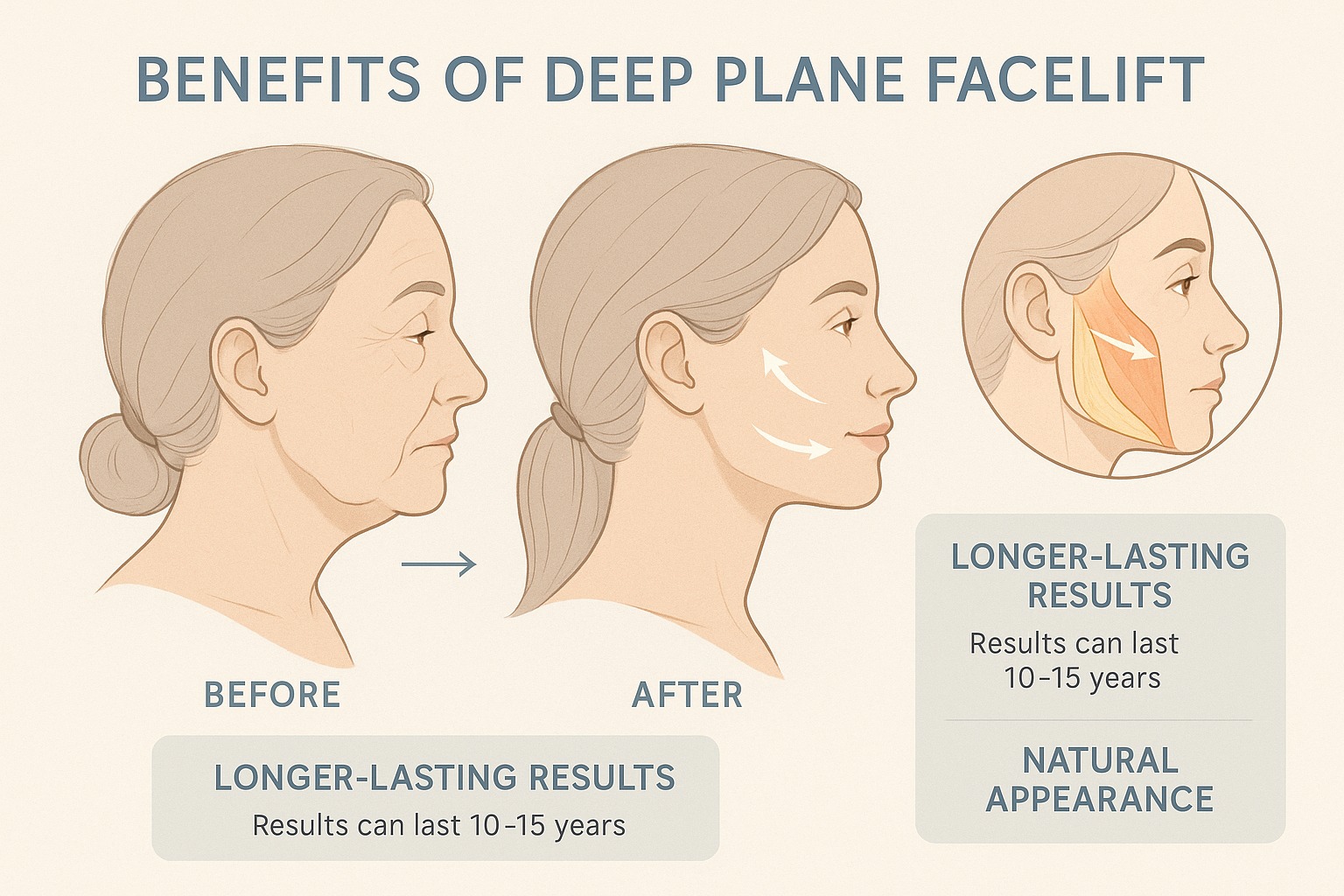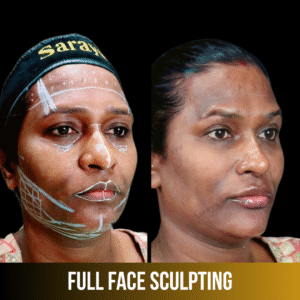Introduction
Facial aging manifests as sagging skin, deepening folds, and loss of youthful contours—concerns that drive many to seek facelift surgery. However, not all facelift techniques deliver the same results. The deep plane facelift has rapidly emerged as the “gold standard” for patients seeking natural, long-lasting facial rejuvenation. Especially in a discerning city like New Delhi where expectations run high, understanding why the deep plane technique stands apart is essential for making an informed choice.
This guide explains the science, advantages, procedure steps, recovery, and key reasons why the deep plane facelift is redefining facial rejuvenation for men and women across India.

What Is a Deep Plane Facelift?
A deep plane facelift is an advanced surgical technique designed to rejuvenate the face by repositioning not just the skin but the underlying SMAS (Superficial Musculoaponeurotic System) and deeper facial tissues. Unlike traditional facelifts that merely tighten skin or the superficial SMAS layer, the deep plane approach addresses the actual root causes of facial aging—sagging ligaments and descended fat pads.
How does it work?
- The surgeon delicately lifts and repositions tissues beneath the SMAS layer, around the cheeks, jawline, and nasolabial folds.
- This approach releases key retaining ligaments, mobilizing the facial “cheek mass” for a true midface lift.
- The skin is redraped with minimal tension, reducing unnatural “pulled” looks and ensuring more durable results.
Ideal Candidates:
Patients in their 40s to 70s with moderate to severe jowling, pronounced nasolabial folds, and midface drooping. Deep plane facelifts are especially effective for those who want to address laxity in the cheeks and lower face comprehensively.
Deep Plane vs. SMAS vs. Traditional Facelift
| Technique | Layers Targeted | Key Benefits | Longevity |
| Skin-Only | Skin | Quick recovery; less durable | 2–3 years |
| SMAS Facelift | Skin + SMAS layer | Moderate improvement, still limited | 5–7 years |
| Deep Plane | Skin + SMAS + Deep Tissue | Most natural; best for midface/lower face | 10+ years |
Deep plane lifts move the entire facial unit, not just the skin, making improvements more harmonious and longer-lasting.
Unique Benefits of the Deep Plane Facelift
- Unmatched Natural Results
The deep plane technique allows for movement of the underlying facial “foundation,” preserving natural facial expressions. Instead of a tight, windblown appearance, patients regain soft, youthful contours free from visible tension. Cheek fullness is restored, nasolabial folds are smoothed, and the jawline looks sharper—without looking “operated upon.”
- Long-Lasting Rejuvenation
Because the deep plane releases and repositions ligaments and compartments at the structural level, results typically last 10 years or longer. By contrast, skin-only or standard SMAS facelifts stretch or lift tissues superficially—so gravitational descent recurs sooner.
- Superior Improvement of the Midface and Lower Face
Traditional facelifts often neglect the midface (the cheeks under your eyes), a giveaway of aging and surgical intervention. Deep plane lifts address this critical area, reducing nasolabial folds, restoring cheek highlight, and naturally blending the lower eyelid/cheek junction.
- Lower Risk of Skin Tension and Complications
With less stress on the skin closure, deep plane lifts reduce risk of wound healing problems, unattractive scarring, or visible “step-offs” at incision lines—common complaints in skin-focused procedures.
- More Predictable and Elegant Outcomes
This technique allows experts like Dr. Adarsh Tripathi to precisely tailor correction to each patient’s anatomy, optimizing symmetry and “personalized aging” rather than forcing everyone into the same mold.
The Deep Plane Facelift: Step-by-Step
- Comprehensive Consultation
Digital facial analysis, high-res photography, and 3D rendering help map aging zones and set realistic goals in the context of your overall bone structure and fat pads. - Anesthesia & Incisions
Surgery is performed under general anesthesia or sedation with local anesthesia for maximal safety and comfort.
Incisions are meticulously hidden in the natural creases around the ears and sometimes along the hairline. - Deep Plane Dissection
Using microsurgical techniques, the surgeon carefully lifts the skin with its underlying SMAS, then releases key retaining ligaments. The midface, lower face, and jowls are gently elevated en bloc (as a unit). - Tissue Repositioning and Redraping
Facial fat, muscle, and ligaments are resuspended at a higher, more youthful position. Skin is re-draped with almost zero tension—minimizing both visible scars and the risk of the “pulled” look. - Closure & Dressings
Meticulous closure techniques protect hair follicles and contour, helping incisions to heal imperceptibly. Compression dressings may be used for 1-2 days.
Recovery, Results & Aftercare
- Duration: Most patients go home the same day or after a single night.
- Normal Swelling/Bruising: Improves significantly in 1-2 weeks; by 2-3 weeks, patients usually return to public life with confidence.
- Final Results: Become apparent as swelling resolves over 1–3 months; incisions fade over six months to a year.
- Pain Control: Modern techniques and anesthesia ensure comfort; typically mild pain, easily managed with regular medication.
- Activity: Desk work in ~7–10 days. Strenuous exercise should be avoided for 3–4 weeks.
- Aftercare: Elevate head, avoid direct sunlight, use cold compresses, and follow prescribed wound-care instructions for optimal healing.
Safety, Risks, and Complications
With an experienced facial surgeon, the deep plane approach is as safe as other facelift techniques, with added benefits from reduced skin tension.
Possible risks include:
- Temporary bruising/swelling
- Numbness (resolves in weeks)
- Minor asymmetry (usually resolves as swelling fades)
- Rare: Hematoma, infection, scarring, or nerve weakness
Rigorous planning, patient education, and careful surgical technique greatly reduce risk.
Before & After: The Transformation
- Youthful cheek fullness, less prominent nasolabial folds
- Smoother jawline and neck contour
- Maintained facial identity and natural movement
- Discreet, nearly invisible scars behind the ear/hairline
View our gallery for before-and-after comparisons, or schedule a 3D imaging consult for a personalized “simulation.”
Frequently Asked Questions
Q: How long do results really last?
A: Most patients enjoy results for 10–15 years, with a softer recurrence of aging.
Q: Can I combine a deep plane facelift with other procedures?
A: Yes—blepharoplasty (eyelid surgery), browlift, fat transfer, or skin resurfacing are commonly combined for comprehensive rejuvenation.
Q: Is the deep plane approach much more expensive?
A: It may be slightly higher than a standard lift due to time and surgical skill, but the greater longevity and natural look provide more value.
Q: When can I return to work or public life?
A: Most people resume desk work and daily errands in 10 days, while public/social appearances are advised after 2–3 weeks.
Why Choose Dr. Adarsh Tripathi in New Delhi?
- Board-certified Maxillofacial & Facial Plastic Surgeon
- Deep expertise with the latest, globally recognized facelift methods
- High-tech surgical suite in GK-1, South Delhi
- Personalized treatment and exceptional safety protocols
- Realistic digital simulations and image guidance for best outcomes

Ready for Your Transformation?
Schedule a comprehensive consultation at Dr. Adarsh Tripathi’s clinic in Greater Kailash, New Delhi, to assess your facial aging and discuss whether a deep plane facelift is your best choice for long-lasting, natural facial rejuvenation.

